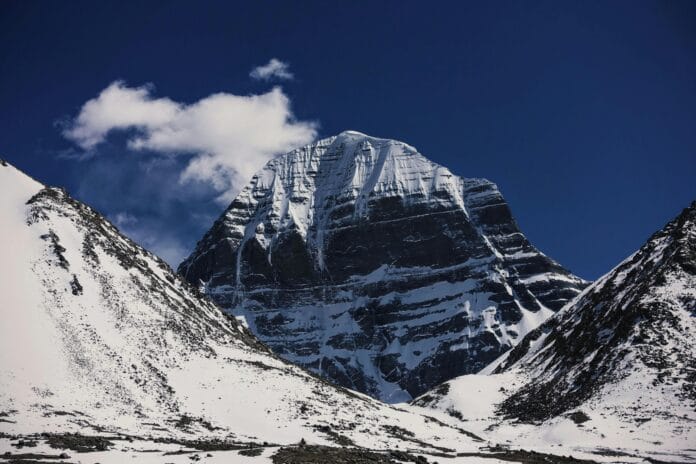Table of Contents
Introduction
Before the first light of dawn breaks over the Himalayas, the sacred landscape of Mansarovar awakens in hushed reverence. The icy air, the shimmering silhouette of Mount Kailash reflected in the tranquil lake, and the flutter of prayer flags create an atmosphere charged with spiritual energy. This is the starting point of the revered Kailash Mansarovar Yatra — a journey not just across rugged terrain, but deep into the heart of devotion, endurance, and self-discovery. For centuries, pilgrims from across the world have come here, drawn by faith and the timeless allure of a mountain believed to be the abode of Lord Shiva. This yatra is more than a physical trek — it is a transformative pilgrimage that tests the body and uplifts the soul.
Spiritual Significance Across Traditions
The Kailash Mansarovar Yatra is more than a journey through rugged Himalayan terrain — it is a sacred passage through the beliefs and histories of some of the world’s oldest religions. For millennia, this remote yet spiritually charged region has drawn pilgrims seeking not just divine blessings, but inner liberation.
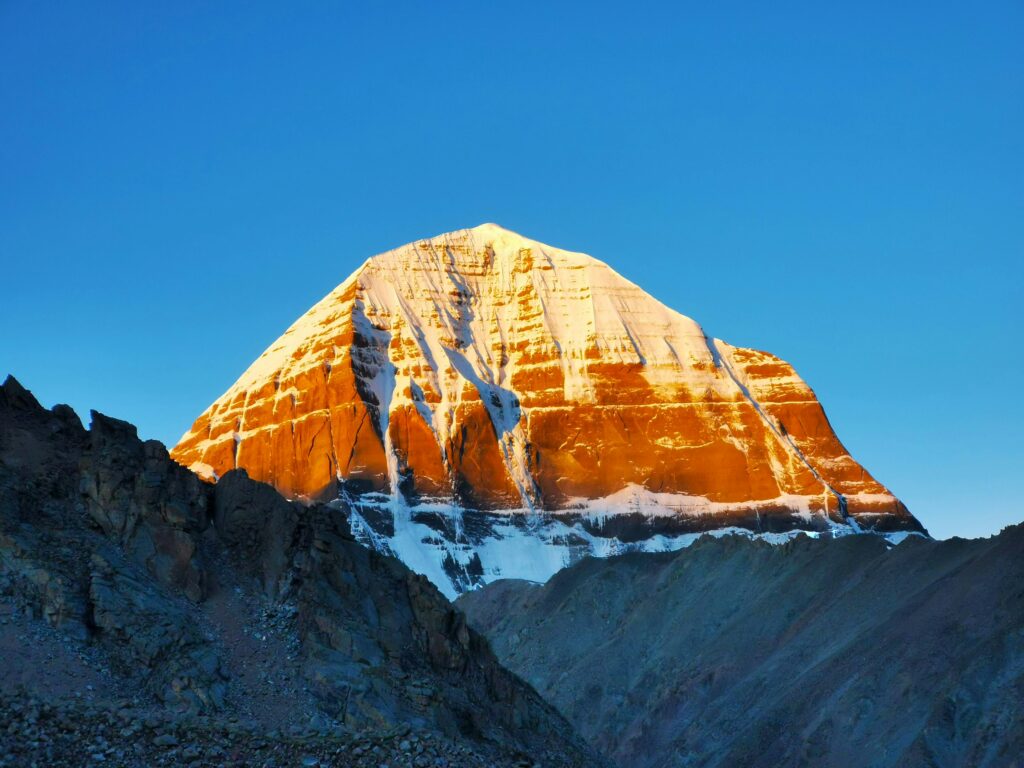
Hinduism: The Abode of Lord Shiva
For Hindus, Mount Kailash is no ordinary mountain. It is the celestial throne of Lord Shiva, the cosmic yogi immersed in eternal meditation. Ancient scriptures revere Kailash and the adjacent Lake Mansarovar as the holiest of pilgrimage destinations. Taking a dip in the lake’s icy, crystal-clear waters is said to cleanse one’s sins and purify the soul — a ritual that echoes the legend of Shiva taming the mighty Ganges on these sacred shores.
References to Kailash and Mansarovar also appear in the epics of the Ramayana and Mahabharata, where they are portrayed as realms of divine presence and spiritual merit. The lake itself, Manasarovar (meaning “Lake of the Mind”), is believed to have been created by Lord Brahma, symbolizing the divine origin of thought and consciousness.
Buddhism: The Axis of the Universe
To Tibetan Buddhists, Mount Kailash is known as Kang Rinpoche, or “Precious Jewel of Snow.” It is seen as the earthly manifestation of Mount Meru, the mythical center of the universe in Buddhist cosmology. The mountain represents a spiritual axis, connecting the human world to the divine.
In Buddhist lore, Queen Maya is said to have bathed in Lake Mansarovar before giving birth to Lord Buddha, symbolizing the lake’s sanctity and life-giving purity. Many sacred sites in the region are associated with Guru Padmasambhava, the 8th-century saint who brought Buddhism to Tibet, as well as mystic encounters between Milarepa, a Tibetan yogi, and Bon sorcerers — stories that continue to inspire pilgrims and seekers.
Jainism: Path to Liberation
In the Jain tradition, Mount Kailash is believed to be Ashtapada, the mountain where Rishabhadeva, the first Tirthankara, attained moksha (liberation from the cycle of rebirth). Nearby Lake Mansarovar is also revered, symbolizing purity and spiritual awakening. Jain pilgrims trace this path with deep reverence, reflecting on the values of renunciation and self-realization that their tradition upholds.
Bon Religion: The Sacred Seat of the Goddess
The ancient Bon religion of Tibet, predating Buddhism, also holds the Kailash Mansarovar Yatra as deeply sacred. To Bonpos, Mount Kailash is the spiritual home of the sky goddess Sipaimen, and Tonpa Shenrab, the founder of Bon, is said to have bathed in Lake Mansarovar. The mountain and its surroundings are rich in Bon symbolism — the snow lion of the mountain, the horses and peacocks of its rivers, and the elephants of the valleys — all woven into a vibrant spiritual cosmology.
Majestic Tibetan Landscapes – A Journey to Mount Kailash and Mansarovar
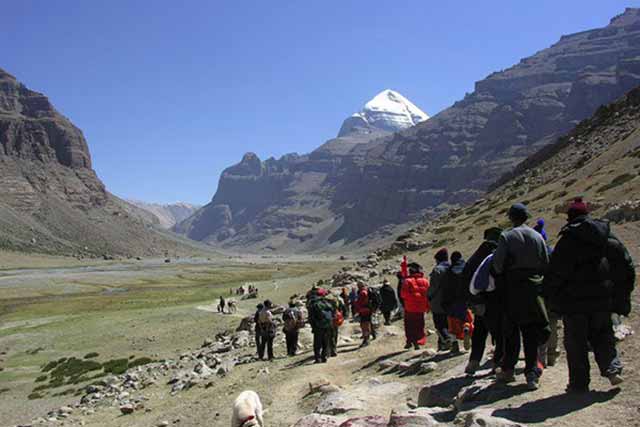
Mount Kailash – The Sacred Summit
Mount Kailash rises like a towering pyramid above the windswept Tibetan Plateau, its flawless peak piercing the sapphire sky. At 6,638 meters (21,778 ft), this sacred mountain dominates the western Transhimalayan Gangdisê range. Ancient belief holds that its four sheer faces are made of crystal, ruby, gold, and lapis lazuli, creating a vision so divine that pilgrims stop in awe.
Beneath Kailash’s shadow lie two of the world’s most spiritually significant lakes—Mansarovar and Rakshastal. Mansarovar’s freshwater purity contrasts sharply with the saline Rakshastal, representing the duality of light and shadow, creation and destruction.
This high-altitude terrain is more than majestic—it’s mythic. From here spring the four great rivers of Asia: the Brahmaputra (Yarlung Tsangpo), Indus, Sutlej, and Karnali (a Ganges tributary). Few places on Earth birth so much life from such barren beauty.
Glaciers rumble silently across the valleys, where pikas scurry, yaks graze, and every mountain breeze seems to carry a prayer. At the foot of Kailash lies Darchen (4,670 m), the tiny pilgrim village where the sacred journey begins, and prayer wheels spin endlessly under Lord Shiva’s gaze.
To the south, Lipulekh Pass (5,115 m) marks the border between India and Tibet, ascending through Uttarakhand’s Mahakali Valley. From here, a narrow mountain road—used by India’s Yatra buses—rises to one of the most breathtaking viewpoints of Mount Kailash.
Lake Mansarovar – Mirror of the Mind and Soul
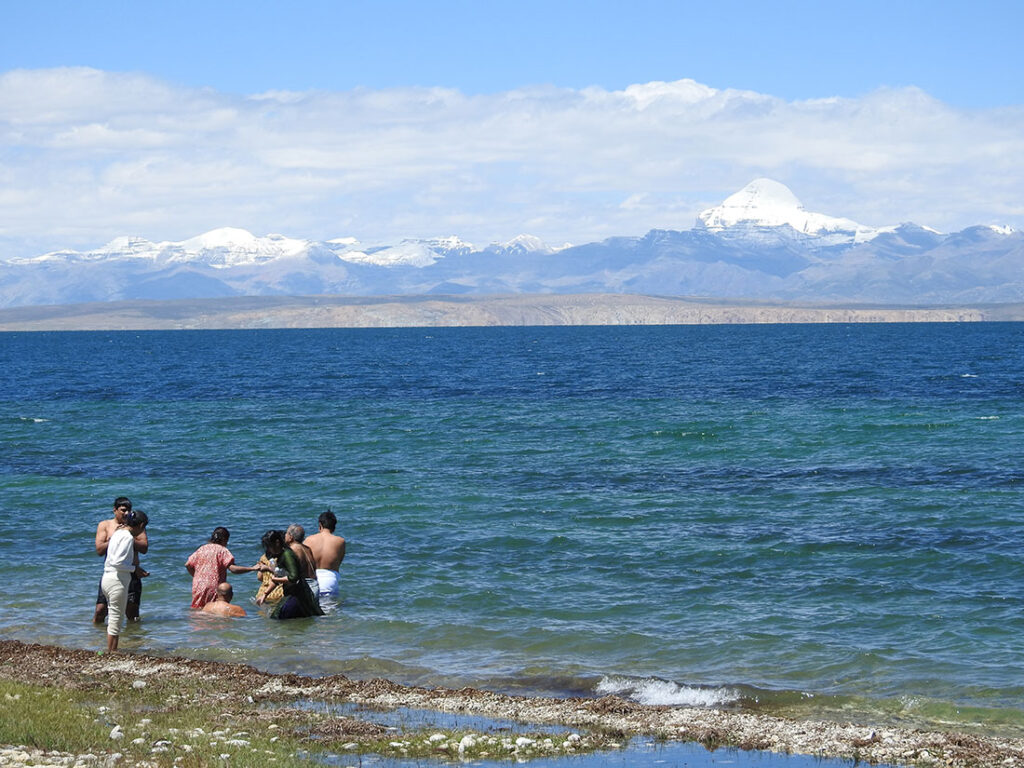
Just 30 kilometers north of Kailash, Lake Mansarovar gleams like a celestial eye. At 4,590 meters, it is recognized as the highest freshwater lake in the world. Its crystal-clear waters are not just physically pure but spiritually potent.
Hindus believe the lake was created in the mind of Lord Brahma, and thus its name—Mansarovar—means Lake of the Mind. Pilgrims from Hinduism, Buddhism, Jainism, and the Bon tradition gather here for ritual bathing, believing its waters cleanse the sins of a lifetime.
The morning dip in Mansarovar is more than ritual—it is a spiritual awakening. Pilgrims enter the water in silence, each seeking forgiveness, healing, and grace.
Lipulekh Pass & Darchen – Thresholds of Faith
Beyond the lake, the trail slowly climbs to the Lipulekh Pass, the spiritual and geographic gateway to Tibet. At 5,115 meters, it’s a windblown crossing through meadows and rhododendron patches, often covered in mist and snow.
From the Indian side, pilgrims enter Tibet via this pass, catching their first view of Kailash’s white crown from the Chinese plateau. Descending from Lipulekh, travelers reach Purang (Taklakot)—a bustling town where Indian and Tibetan cultures converge.
From Purang, all paths lead to Darchen, the spiritual basecamp at Kailash’s southern face. At 4,670 meters, this dusty hamlet welcomes pilgrims preparing for the arduous yet transformational Kora—the sacred trek around the mountain.
Key Stages of the Yatra
1. Holy Dip in Lake Mansarovar
The Yatra begins with a holy dip in Lake Mansarovar, an act of spiritual cleansing and surrender. Before dawn, pilgrims line up at the water’s edge, wrapped in woolen blankets. Under the light of early morning stars, they whisper prayers and step into the icy water.
A small hawan (fire ritual) follows, offering gratitude to the gods and invoking protection for the journey ahead.
2. Circumambulating Kailash (Kora / Parikrama)
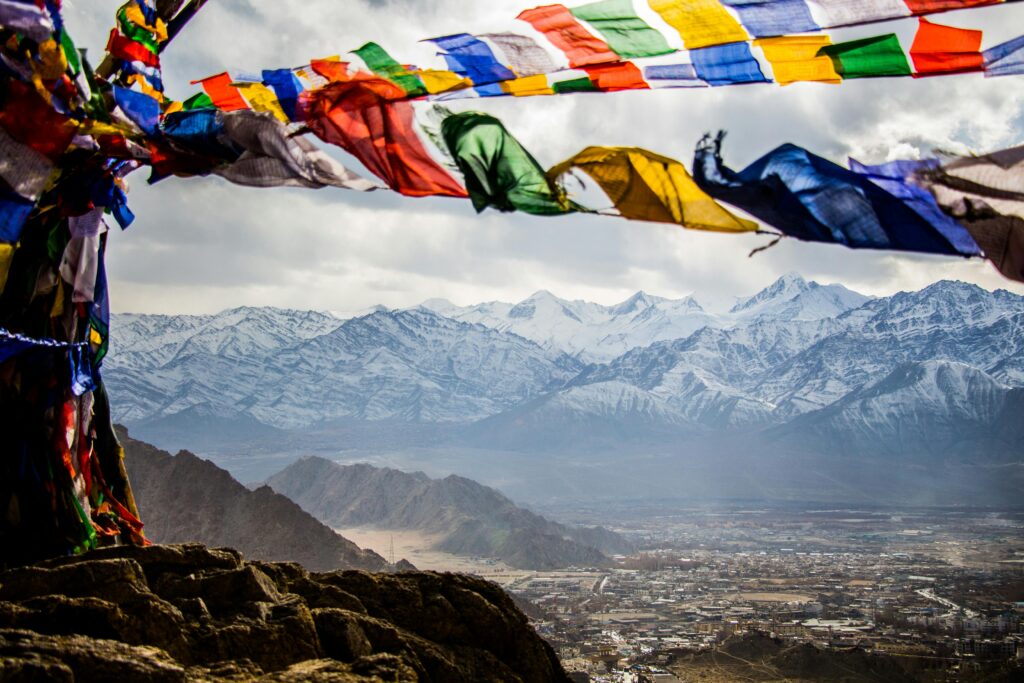
The heart of the pilgrimage is the 52–53 km parikrama around Mount Kailash, performed clockwise by Hindus and Buddhists, and counterclockwise by Bon practitioners.
- Day 1: The journey begins from Darchen to Dirapuk Monastery (about 14 km), located near the foot of Kailash’s north face. Here, the glacier and the looming mountain dominate every step.
- Day 2: Before sunrise, the toughest stretch begins—climbing to Dolma La Pass (5,650 m), the highest point on the trek. Oxygen levels drop drastically, making each step a test of will. At the summit, pilgrims offer prayers and flags, and bow their foreheads to the sacred earth. “They say one step here equals 1,000 recitations of ‘Om Namah Shivaya’ and burns away a lifetime of karma.” The descent continues past Gauri Kund and down to Zutulphuk Monastery (~19 km).
- Day 3: The final 20 km stretch returns pilgrims to Darchen over gentler terrain.
Overland Routes: Via India or Nepal
Pilgrims undertaking the Kailash Mansarovar Yatra can travel via two main overland routes — through India or Nepal — each offering its own unique blend of challenge and convenience.
India Route (Uttarakhand & Sikkim)
Organized by India’s Ministry of External Affairs, the Indian route typically runs June to September. The Uttarakhand path passes through Dharchula, Gunji, and the high-altitude Lipu Lekh Pass (5,100 m), now more accessible via a new motorable road. A secondary route via Sikkim’s Nathu La Pass (requires an Inner Line Permit) is more restricted but equally scenic. Both routes enter Tibet at Purang, leading onward to Lake Mansarovar and Mount Kailash. These journeys are well-coordinated, group-based, and ideal for first-time yatris seeking structured support.
Nepal Route (Simikot & Kerung)
Preferred by many international and NRI pilgrims, the Nepal route is more flexible and quicker. Pilgrims fly from Kathmandu to Simikot via Nepalgunj, then take a jeep or helicopter to Hilsa, crossing into Tibet at Purang. The alternate Rasuwa–Kerung route also remains open. As of June 2025, the Nepal–Tibet corridor is fully operational. Most travelers arrange visas and Tibet permits via Kathmandu-based tour operators, making this route popular for its ease, affordability, and scenic appeal.
Travel Tips and Practical Information
Embarking on the Kailash Mansarovar Yatra is as much a physical and logistical commitment as it is a spiritual calling. Proper planning and preparation are key to ensuring a safe, meaningful experience in this remote Himalayan frontier.
Best Time to Visit
The Yatra season typically runs from June to September, when the high mountain passes are accessible. However, the best travel windows are:
- May–June (pre-monsoon): Clear skies, mild temperatures (5–15°C), and less crowding.
- September–October (post-monsoon): Crisp air, golden landscapes, and stable weather.
Avoid July–August, as the monsoon can bring landslides and travel disruptions. Winters (Nov–Apr) are brutally cold and not suitable for travel.
Physical & Mental Preparation
The Kailash Mansarovar Yatra takes you to extreme altitudes (up to 5,650 m at Dolma La Pass) and rugged terrain. Prepare your body and mind at least 2–3 months in advance:
- Fitness training: Cardio hikes (5–10 km daily), stair climbing, cycling, and breathing exercises (like pranayama).
- Strength workouts: Focus on core and leg muscles (squats, lunges, weighted packs).
- Altitude practice: “Climb high, sleep low” techniques if accessible.
- Hydration & health: Drink plenty of water, avoid alcohol, and consult a doctor about altitude meds like Diamox. Portable oxygen cans are useful backups.
- Mental readiness: Move slowly, rest often, and pace yourself—altitude sickness can affect even the fittest trekkers.
Permits & Documentation
Due to the sensitive border region, private travel is not allowed. All pilgrims must book through authorized operators and acquire several official documents:
For Indian Citizens:
- Register online with India’s Ministry of External Affairs (MEA) between January–March.
- Submit medical forms, and if selected, you’ll be guided through:
- Chinese Group Tourist Visa
- Tibet Travel Permit (TTP)
- Restricted Area Permit (RAP) (handled by tour agency)
- If taking the Sikkim route, an Inner Line Permit (ILP) is also required.
For Foreign & Nepalese Pilgrims:
- A valid passport (min. 6 months) is required.
- Tour operators will assist with:
- Chinese Visa
- Tibet Travel Permit (TTP)
- Restricted Area Permit (RAP)
Always carry physical copies of all documents — passport, visa, permits, and insurance — as they’ll be checked at multiple points along the journey.
Additional Tips
- Travel insurance that covers high-altitude trekking and emergency evacuation is highly recommended.
- Emergency contacts, a basic first-aid kit, and portable snacks (nuts, glucose, energy bars) should always be in your day pack.
- Respect local customs: walk clockwise around Mount Kailash (except Bon pilgrims), avoid littering, and maintain spiritual decorum.
Packing List: Travel Light but Smart
Preparing your gear carefully can make all the difference on the challenging Kailash Mansarovar Yatra. Here’s what to pack for a safe, comfortable, and spiritual trek:
Clothing
- Layered warm clothes: thermal base layers, fleece or wool sweaters, and a heavy down or windproof jacket. Nights at 4,500–5,000 meters can be freezing.
- Woolen hats, gloves, scarves — essentials for biting cold.
- 2–3 pairs of trekking pants (include at least one rainproof pair).
- Moisture-wicking T-shirts and several pairs of warm socks (plus extras).
Footwear
- Sturdy, waterproof, well-broken-in hiking boots with strong ankle support.
- Thick wool or synthetic socks (multiple pairs).
- Gaiters to keep dust and debris out on rough trails.
Trek Gear
- A 40–60L backpack with a rain cover for daily essentials.
- Trekking poles or a walking stick to reduce knee strain on steep descents.
- Warm sleeping bag rated for -20°C or lower (if camping).
- Basic lodges or army-style camps are typical overnight stops, so pack accordingly.
Sun and Cold Protection
- High-SPF sunscreen and lip balm.
- UV-blocking sunglasses to protect against intense Himalayan sun.
- Moisturizer and chapstick to combat dry mountain air.
Hydration & Health
- Water bottles or hydration bladder plus purification tablets/filters (safe drinking water is limited).
- Medical kit: painkillers, Diamox for altitude sickness, blister pads, rehydration salts, personal meds.
- Hand sanitizer and quick-dry towel.
Documents & Essentials
- Original passport, visa pages, group permits, Tibet Travel Permit (TTP) — keep physical and photocopies.
- Passport-sized photos (useful for permits or emergencies).
- Personal first-aid kit and prescription medications.
- Energy bars, dry fruits, glucose powder for quick nutrition.
- Multi-tool and headlamp with extra batteries.
Miscellaneous
- Camera (batteries drain quickly in cold weather).
- Travel journal to capture reflections and memories.
- Small padlock and travel adaptor (voltage differs by region).
- Modest swimwear and microfiber towel for the ritual dip in Lake Mansarovar (many prefer white undergarments).
On the Trail – What to Expect

The Kailash Mansarovar Yatra is far from a luxury trip. Accommodation along the route is basic but clean — you’ll stay in simple guesthouses, army tents, campsites, or even monasteries. Rooms are typically shared by 2–4 people and may have squat toilets and bucket showers. Hot water and electricity can be scarce or intermittent.
Meals are rustic and hearty, mostly vegetarian with Tibetan-Chinese influences: expect dals (lentils), rice, tsampa (barley flour), roti, noodles, and soup. Tea or coffee is served morning and evening, so bring electrolyte packets to stay energized.
Days begin early, often before sunrise, to avoid afternoon storms and heat on the high passes. Trekking sessions last 5–7 hours at a steady, slow pace with frequent breaks. The air is cold and dry, so cover your skin and prepare for breathlessness during the first days. Many trekkers carry oxygen tanks or concentrators and recommend acclimatizing for a day or two in Lhasa or Kathmandu.
Altitude sickness—headache, nausea, fatigue—is common, so listen to your body and don’t push too hard. Weather can change suddenly, with summer snow flurries or hail, especially on passes like Dolma La.
Respect local customs at every stop: dress modestly, remove shoes before entering temples, and never litter—carry out all trash, including tissues, to keep this sacred landscape pristine.
Expect minimal phone or internet connectivity; some camps have satellite phones but regular signals are patchy. Embrace the silence, the fluttering prayer flags, the crunch of gravel underfoot, and the distant bells of yaks. Many pilgrims find a deep mental clarity arises once city noise fades, leaving only focused steps and heartfelt prayers.
A Journey That Leaves an Imprint on the Soul
Ultimately, the Kailash Mansarovar Yatra is as much an inner journey as it is a physical expedition. Whether standing in silence on the emerald shores of Lake Mansarovar at dawn, struggling for breath on the steep crest of Dolma La, or walking among chanting pilgrims beneath the gaze of the silent mountain, each moment carves itself into the soul.
Pilgrims often say you return from Kailash carrying a piece of it in your heart—a lasting sense of humility, awe, and deep spiritual connection to something timeless and vast. It’s more than just a trek; it’s a walk through the essence of faith itself
The Yatra tests the body, uplifts the spirit, and binds each traveler to centuries of devotion, myth, and prayer. With proper preparation, respect for local customs, and an open heart, it becomes a transformational adventure—one to be treasured, remembered, and retold for a lifetime.

